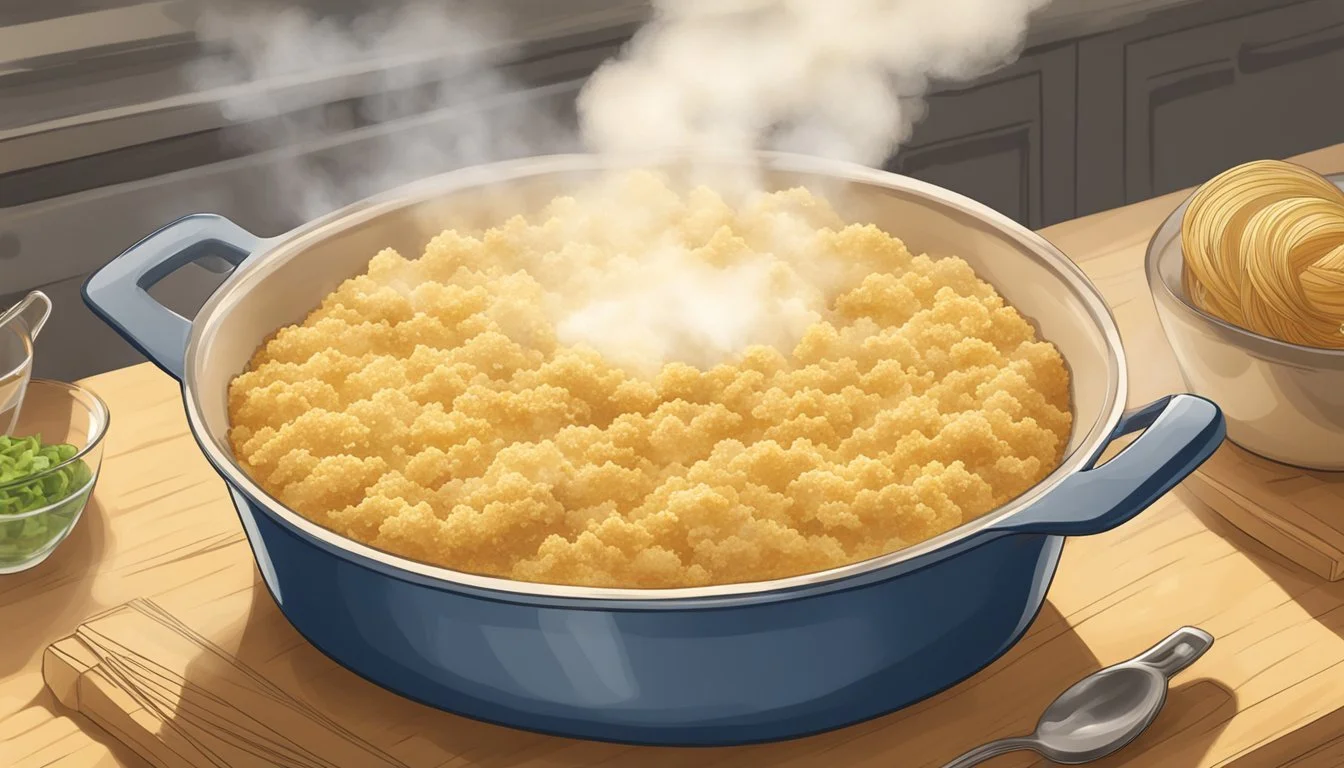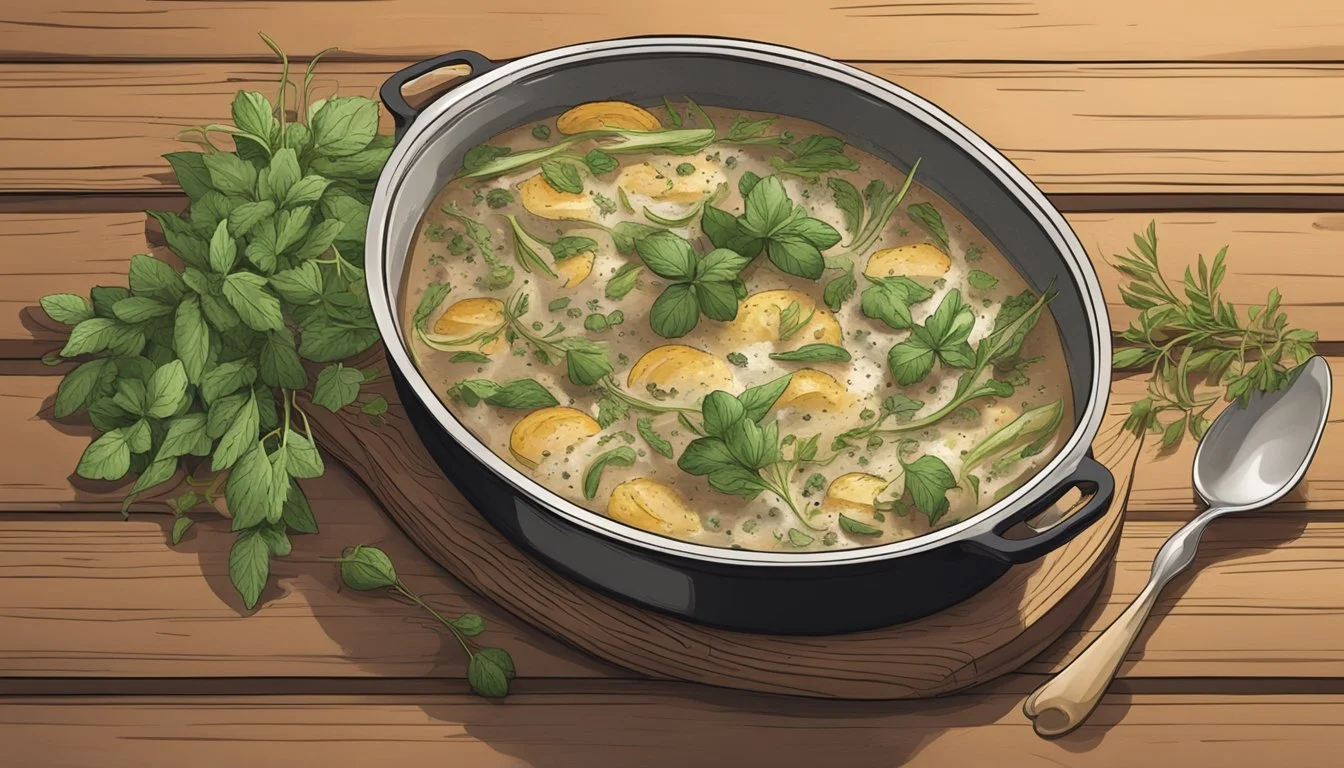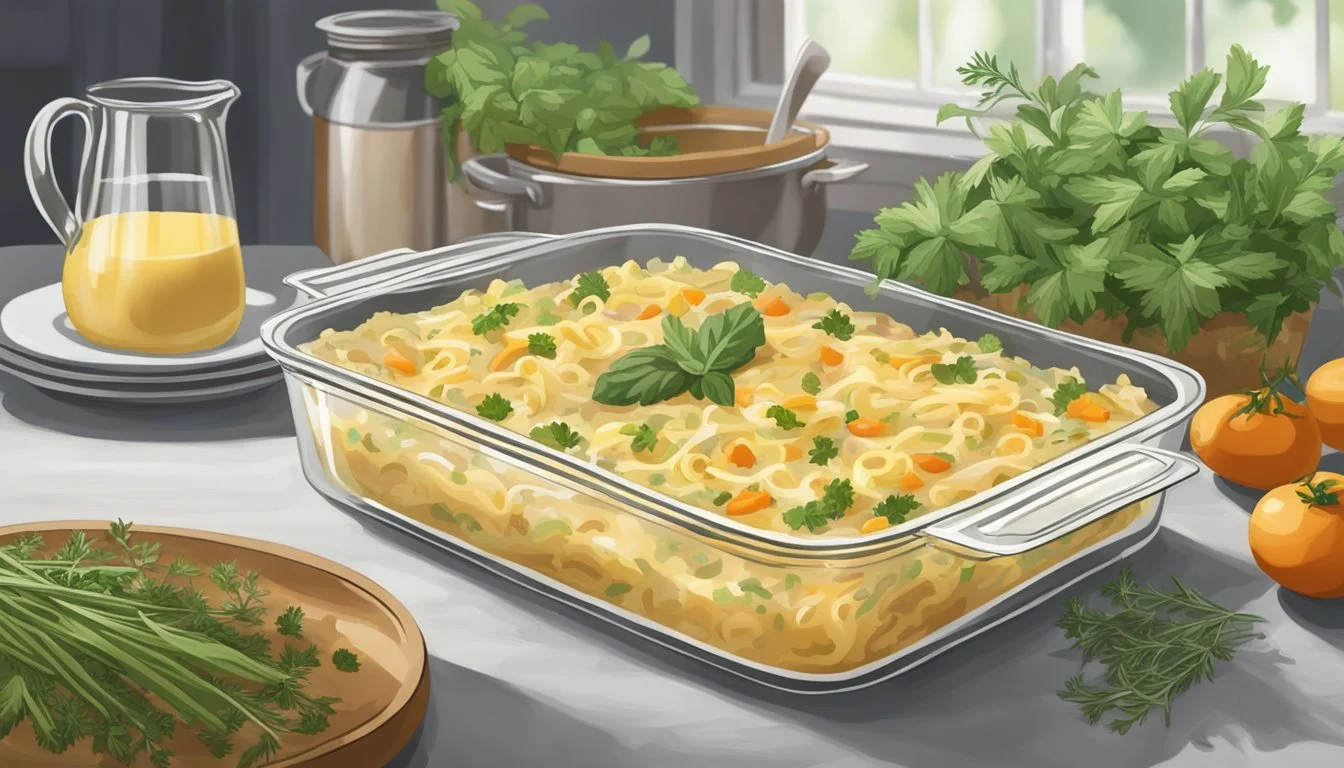Best Way to Reheat Chicken Noodle Casserole
Tips for Creaminess and Flavor Preservation
Reheating a chicken noodle casserole requires a gentle touch to preserve its creamy texture and robust flavor. A well-reheated dish can rival the taste and appeal of its freshly baked counterpart. Understanding the balance of temperature and timing is key to avoiding a dried-out or unevenly warmed casserole. The choice of reheating method plays a crucial role in achieving a moist and flavorful result.
The oven is often deemed the most effective technique for reheating a chicken noodle casserole. It provides steady, even heat that ensures the casserole warms throughout without losing its creamy consistency. To begin, the casserole should rest at room temperature before it is warmed, preparing it for an even reheat and protecting bakeware. Covering the dish aids in retaining moisture which is essential for keeping the creamy aspect of the casserole intact while preventing the noodles from drying out. A moderate oven temperature, generally recommended at 350°F (175°C), allows for a thorough heat without the risk of overcooking or burning the edges.
Understanding Chicken Noodle Casserole
Chicken noodle casserole is a comfort food staple that combines tender pieces of chicken, savory broth, and hearty veggies, all nestled within a creamy sauce and layered with egg noodles. The dish is often baked with a cheese topping that adds a delightful crispness and a deeper flavor profile.
Composition:
Chicken: The protein base, usually cooked and diced or shredded.
Broth: Low-sodium chicken broth is typically used to enhance the depth of flavor.
Veggies: Common choices include peas, carrots, and broccoli, offering nutrition and texture.
Egg Noodles: Wide egg noodles are preferred for their robust structure that holds up well under the sauce.
Sauce: A mixture of cream of chicken soup and all-purpose flour, along with seasonings, creates a rich base.
Cheese: Shredded cheese, such as cheddar or a blend, is often included within the casserole and as a topping for a gooey element.
Topping: Ingredients like buttered breadcrumbs or crushed crackers can be sprinkled on top before baking to provide a crunchy contrast.
The beauty of chicken noodle casserole lies in its versatility. Different types of cheese and a variety of vegetables can be used to cater to personal tastes. Key to its preparation is a balance between the ingredients, ensuring that the noodles are cooked al dente and the sauce remains creamy, enveloping each component without drying out during the baking process.
Preparation Before Reheating
Before reheating a chicken noodle casserole, there are several key steps to ensure it remains creamy and flavorful. Initially, preheat your oven to 350°F (175°C). This moderate temperature allows the casserole to warm evenly without drying out.
For those dealing with leftovers, it is recommendable to remove the casserole from the refrigerator and let it sit at room temperature for about 30 minutes before heating. This step reduces the temperature shock to the ingredients and contributes to even reheating.
Next, prepare your baking dish. If you stored your casserole in the dish you baked it in, it may simply need a cover. Otherwise, transfer the casserole to an oven-safe dish that can accommodate its size.
Covering the Casserole:
Foil: Tightly cover the dish with aluminum foil before placing it in the oven. The foil traps in moisture, preventing the top from drying out before the middle is warm.
Oven-Safe Dish Tips:
Materials: Choose a dish made of glass or ceramic for best heat distribution.
Space: Make sure there is enough room around the casserole for air to circulate.
By following the original casserole recipe's indications and adjusting for a reheating process, not only will the food maintain its textures, but it will also retain the original flavor profiles that make chicken noodle casserole a comforting and hearty dish.
Reheating Chicken Noodle Casserole in the Oven
Reheating chicken noodle casserole in the oven is a reliable method to ensure it remains creamy and flavorful. This process involves setting the correct temperature, preparing the dish carefully, and covering it to retain moisture.
Preheat the Oven
Before reheating the casserole, one must preheat the oven to 350°F (175°C). This is an important step to guarantee the dish heats evenly throughout. Using an oven thermometer is advised to ensure the oven reaches the desired temperature.
Prepare the Casserole
It's essential to use an oven-safe dish when reheating the casserole to avoid any damage to the dish or the oven. Transfer the chicken noodle casserole into the dish if it's not already in one. To avoid uneven warming, one should allow the casserole to come to room temperature for about 30 minutes before placing it in the oven.
Cover with Foil
To prevent the top from drying out and to promote heat retention, cover the casserole with aluminium foil. Ensure that the foil creates a seal around the edges of the baking dish, which helps to lock in moisture.
Bake to Perfection
Place the covered casserole in the oven once it is preheated. Bake for 20-30 minutes, checking periodically. The dish is properly reheated when it reaches an internal temperature of 165°F. One should always use oven mitts to remove the dish safely.
Microwave Reheating Method
Reheating chicken noodle casserole in the microwave can be quick and efficient if done properly. This section provides detailed steps to ensure the casserole retains its creaminess and flavor.
Setting the Microwave
Firstly, one must prepare the microwave for reheating leftovers. Place the chicken noodle casserole in a microwave-safe container. If the container has a lid, leave it slightly ajar to allow steam to escape. Alternatively, cover the casserole loosely with a microwave-safe lid or a piece of microwave-friendly plastic wrap, again ensuring there’s room for steam to escape. Set the microwave power to medium, which typically corresponds to 50% of its full power, to avoid overheating and drying out the casserole.
Reheating in Stages
Reheat the casserole in stages to promote even heating. Start by setting the timer for two minutes and then checking the casserole. If it’s not sufficiently warm, stir the casserole if possible, to redistribute the chicken and noodles for more uniform warmth. Continue reheating in one-minute increments, checking after each stage. Reheating in stages prevents overheating, which is crucial for keeping the casserole creamy and avoiding a rubbery texture in the chicken.
Checking for Even Heating
Check the casserole's temperature in several places to ensure even heating. The center tends to be the last part to warm up, so focus on this area when checking. If the casserole is not evenly heated after the initial stages, continue reheating in short bursts, stirring between each to distribute the heat. Once the casserole has reached a uniform temperature and is steamy throughout, it’s ready to be enjoyed.
Maintaining Creaminess and Flavor
To preserve the creamy texture and rich flavor of a chicken noodle casserole during reheating, one must add moisture and manage temperature effectively. These methods prevent drying out and ensure food safety.
Adding Moisture
Introduce additional moisture to combat dryness:
Sauce: If the casserole appears dry, gently stir in a small amount of cream of chicken soup to add moisture and flavor.
Sour Cream or Milk: A dollop of sour cream or a splash of milk can rejuvenate the creaminess without diluting the casserole's inherent taste.
Managing Temperature
Heat evenly to maintain quality:
Gradual Heating: A steady oven temperature of 350°F (175°C) allows for even warming without overcooking.
Covering the Dish: Sealing in moisture with aluminum foil prevents the top from drying out and becoming crispy before the interior is heated.
Cooked Pasta: Ensure the pasta remains al dente by avoiding excessive heat, which can make it mushy.
Internal Temperature: Use a food thermometer to check that the casserole reaches 165°F (74°C) to comply with food safety standards without overheating.
Enhancing the Casserole Toppings
Properly reheating your chicken noodle casserole is just one step towards reviving its delectable taste and texture. The casserole's toppings, whether crunchy or cheesy, require special attention to ensure that they retain their texture and complement the creamy noodles and chicken below.
Maintaining Crunchiness
To preserve the crunchiness of a breadcrumb topping after reheating, one should consider lightly toasting the breadcrumbs before spreading them atop the casserole. For panko breadcrumbs, which are known for their lighter, airier texture compared to standard breadcrumbs, tossing them with melted butter in a skillet over medium heat until golden brown will enhance their crispness. Apply them to the casserole during the last few minutes of reheating to avoid sogginess.
Ritz Crackers: Crush and combine with melted butter, then sprinkle over the casserole to add a buttery crunch.
Bread Crumbs / Panko: Toast in butter and scatter on top to retain their texture.
Cheese: Add a layer of cheddar cheese under the crunchy toppings for a balance of creamy and crispy.
Additional Toppings to Consider
One might want to introduce additional toppings to their casserole post-reheating to add a new flavor dimension or to rejuvenate the dish's aesthetics. For a simple yet effective enhancement, mixing shredded cheddar cheese into the breadcrumb mixture can provide both a flavor boost and a pleasant textural contrast. Additionally, a combination of seasoned breadcrumbs mixed with herbs can deliver not only a crunchy topping but also a fresh flavor profile.
Panko Breadcrumbs & Herbs: Combine with fresh parsley or thyme for a flavorful touch.
Cheddar Cheese: Sprinkle on top after reheating for extra richness.
Buttered Ritz Crackers: Add as a final topping for a satisfying crunch and savory note.
Safety Considerations When Reheating
Reheating chicken noodle casserole requires attention to food safety to prevent foodborne illnesses. It's essential to reheat the casserole to an internal temperature of 165°F, as recommended by food safety authorities. A reliable food thermometer should be used to check the temperature at the center of the casserole to ensure it's heated evenly throughout.
When reheating, one should cover the casserole with a lid or foil to maintain moisture and promote even heating. Foil can also prevent the top from burning or drying out before the center is thoroughly heated. If using a lid in the oven, it's important to ensure that it is oven-safe.
Below are key points to consider for safety:
Internal Temperature: Heat to a safe minimum internal temperature of 165°F.
Heating Method: Reheat the casserole evenly using an oven or a microwave oven.
Covering: Use a lid or foil to ensure even heating and retention of moisture.
Storage: If the casserole has been refrigerated, it should ideally be consumed within 3-4 days.
Leftovers: After reheating, any leftovers should be cooled and refrigerated within two hours.
By maintaining a clean environment and using proper reheating techniques, one can ensure their chicken noodle casserole remains safe, creamy, and flavorful.
Storing Leftover Chicken Noodle Casserole
Proper storing of leftover chicken noodle casserole ensures it remains creamy and flavorful upon reheating. Two critical considerations are how quickly the casserole cools and whether it should be kept in the refrigerator or the freezer.
Cooling and Covering
After serving, one should allow the casserole to cool completely to room temperature; this process should not exceed two hours to maintain food safety. Using an oven-safe dish, sheathing the leftover casserole with a snug cover, such as aluminum foil or a fitted lid, can prevent contaminants and moisture loss during storage.
Refrigerator vs. Freezer Storage
The decision between refrigerating or freezing leftovers depends on when one plans to consume them. For consumption within three to four days, refrigeration in an airtight container is suitable. Conversely, for extended preservation, freezing is advisable. In an oven-safe dish covered tightly, the chicken noodle casserole can be frozen to extend its shelf life for up to three months, though it's best used within one month for optimal taste. When freezing, ensure it's in manageable portions to facilitate easy thawing and reheating later on.
Serving Suggestions and Final Touches
When presenting the reheated chicken noodle casserole, it is crucial to consider the garnishing and side dishes that complement the flavors and enhance the overall dining experience.
Garnishing
The right garnish can significantly elevate the presentation and infuse a fresh dimension into the creamy texture of the chicken noodle casserole. A sprinkle of fresh parsley not only adds a pop of color but also a subtle herby freshness that doesn't overpower the dish. Thyme provides an earthy undertone that aligns well with the heartier elements of the casserole.
Pairing with Sides
To harmonize the meal, sides should be selected that balance the richness of the casserole. Consider these options:
Steamed green beans or asparagus: Their slight crunch and vegetal notes offer a contrast to the creaminess of the casserole.
A citrusy arugula salad: The brightness of the salad cuts through the richness and refreshes the palate.
Garlic bread: Its crisp texture and aromatic flavor profile provide a delightful complement to the soft noodles and creamy sauce.
Choosing the right garnish and side dishes can transform the chicken noodle casserole into a well-rounded and satisfying meal.
Creative Variations for Next-Day Leftovers
When dealing with leftovers, one can enhance the flavor and variety of easy chicken noodle casseroles (What wine goes well with casseroles?) by incorporating new ingredients or transforming it into a completely new dish. These methods assure that the creamy comfort food not only retains its appeal but also offers a new culinary experience.
Incorporating New Ingredients
One can rejuvenate a classic creamy chicken noodle casserole by sprinkling in shredded cheddar cheese, which melts to add a rich, gooey texture. Adding fresh seasoning like salt, pepper, or herbs can brighten up the flavors. To boost the protein content, consider folding in chunks of tender rotisserie chicken or extra shredded chicken. Ingredient notes: Always taste before adding extra salt, especially if the casserole was seasoned adequately the day before.
Transforming into A New Dish
Leftover chicken noodle casserole can serve as a foundation for an entirely different meal. For a hearty breakfast, one might repurpose it into a filling for omelets. The creamy chunks blend well with eggs, providing a savory start to the day. Alternatively, adding a bit more broth can turn the casserole into a comforting, soup-like creation reminiscent of chicken noodle soup. Keep in mind to gently warm the leftovers to preserve the creamy consistency while repurposing.
By utilizing these tactics, leftovers from a make-ahead chicken noodle casserole transform into exciting dishes, ensuring nothing goes to waste while keeping mealtime interesting and satisfying.






